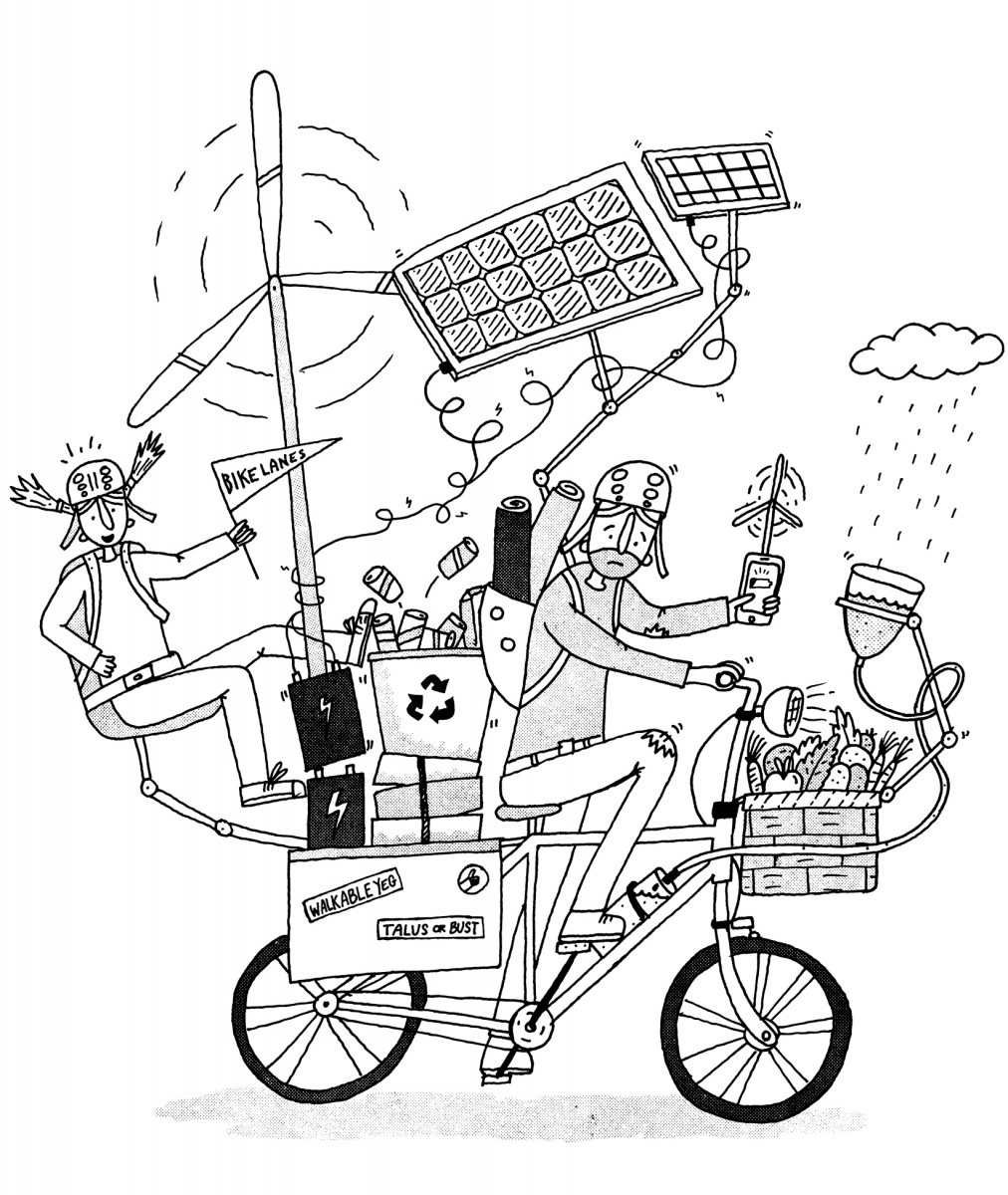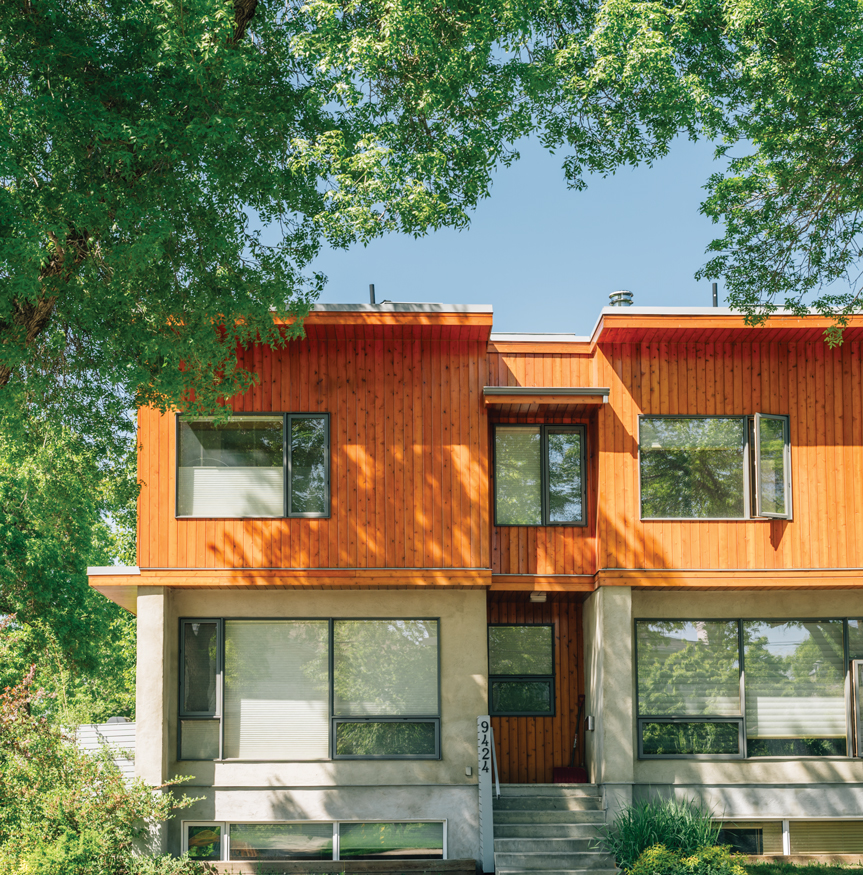
Audric Moses is apologizing for his new house. As he shows me its rooms, we arrive in the kitchen and he motions at the oven, in a cardboard box on the floor. Its future home, beside the fridge, is currently a nest of electrical wires. “We’re still working to finish it,” he says. Then someone rings the doorbell. “I think it might be curtains or something,” Moses says. His son, Raine, 12, and daughter, Aysia, 9, race to the door. It is indeed curtains.
But there’s more to the apologies than the completeness of his new house. Outside, while workers hammer together the emerging suburb of Windermere, Moses’s three-bedroom, 2,800-square-foot house fits right in with its neighbours. It’s only the solar panels, mechanical novelties in the basement and the nearly double-thick walls that hint it can produce as much energy as its occupants use, or be “net-zero” in building parlance. Moses and his wife, Marni, had it built like this, and paid Augusta Fine Homes about $80,000 extra for that.
Moses realizes few will see value in his upgrade, though. In Edmonton, we drive $65,000 pickups that pull expensive, gas-guzzling recreational toys, yet still line up around the block at Costco to save $20 on groceries; so goes our utilitarian balance in an era where energy is cheap and land isn’t. When it comes to our big-ticket spending like houses, then, if we pay a lot more money we want a lot more house, not less energy loss. Moses brings this up, unprompted. “There might be a lot of people who would say, ‘For that extra amount of money you spent on your [net-zero] house, I can get extra square footage,'” he says.
He’s right. That’s exactly what the typical Edmonton homebuyer says, and it’s reflected in the data. Mike Mellross, the Senior Environmental Project Manager with the City of Edmonton, says the small amount of data the city gathers on energy-efficient homes shows that, in 2007, only about five per cent of new homes built in Edmonton carried a buyer-requested EnerGuide rating, a sticker (like the one you see on fridges) noting their performances relative to the average. In 2015, about 11 per cent of new builds have them, with the largest driver being builders’ increased participation in the Build Green Program. This green building certification requires an EnerGuide label and gives builders credibility with their clients who want to know that they have purchased greener homes that are more energy efficient than standard-built homes.

To Mellross, that gain is a win. “It definitely looks like there’s an increase in demand for energy efficiency,” he says. And yet this means barely 10 per cent of new houses sold in Edmonton have been cross-shopped on energy performance, let alone had that performance actively, intentionally improved – a far cry from where the city’s own The Way We Green sustainability plan suggests we might get or where Vancouver already is going, by creating incentives for greener homes.
The reason is doing so costs more – often, a lot more. Moses is willing to spend to go green. Will the rest of Edmonton ever catch up? Surveys show Canadian homebuyers want green houses. Well, to be clear, they want green-er houses. But, to be super clear, they don’t really want to pay for them. Only 40 per cent of homebuyers polled told EnerQuality Corp. researchers in 2009 they’d pay up to $10,000 more for a new house that’s more efficient; the average amount home buyers were willing to spend was $13,183.
Eight years after that study, little has changed. Brent Strachan, with Minto Homes in Ontario, for example, shared that his company has offered net-zero packages on its houses, which add about $65,000 – or 15 per cent – to the sale price of a single-family home.
Not a single buyer has bit, despite the upgrade paying for itself over the long term. “We are seeing that people are finding the cost to get to net-zero to be too high,” Strachan says. “People would rather invest in other areas such as hardwood floors, cabinetry and granite countertops.”
Back here in Edmonton, where the typical every-person is middle class, lives in a modest suburb and stresses about mortgage payments, Moses says convincing buyers will be tough. “If you polled a section of people in Edmonton looking to get into a single-family home, I would guess almost none of them would say they want to be self-sustaining or want a net-zero house,” he says. “If you asked them if they want an energy-efficient house, they would say ‘yes,’ but I don’t think it would be the first concern for many people.”

Confirming Moses’s suspicions, The Canadian Home Builders Association’s 2016 Albertan Home Buyer Preference Survey suggests that energy efficiency is one of the top things Albertans are looking for in a new home. In the survey, 59 per cent said an energy-efficient home is a must-have, with the same amount citing lower utility costs as the reason why. However, only 6.8 per cent actually paid over $7,500 for energy efficiency when purchasing their home and only 5.8 per cent claimed they would spend more than $10,000 on their home in order to save on utilities.
Moses says the why behind his house is partially because he and his wife, Marni, can afford to make an example. Audric is the Manager of the Faculty of Medicine and Dentistry Lipidomics Core Facility, and Marni is the Associate Director of the Centre of Excellence for Real World Clinical Outcomes. “We don’t want our house to be a fashion accessory at all, but we do want to show people who are in similar situations in their life that it is definitely attainable,” he says. Moses says he expects to break even on his extra spend in as little as eight years. “I think that with the cost of solar electricity systems right now, especially factoring in [potential] provincial rebates, it’s totally worth it to install panels.” If you think energy wasting but cheap houses are as Albertan as a pickup pulling a speedboat, you’d partially be right. But Harold Orr would like to teach you some history nonetheless. Orr, who lives in Saskatoon, helped design and build the original Conservation House in Regina, back in the 1970s. The house wasn’t spurred by climate change, but instead by the OPEC energy crisis. “The price of gasoline doubled overnight,” he says.
Heating houses in what builders still call the subarctic, “golden triangle” of Regina, Calgary and Edmonton requires a lot of energy. With energy costs doubling, the Saskatchewan government responded by pondering how to build better, more efficient housing, lest Regina or Edmonton become un-liveably expensive.

The house Orr helped design was a moonshot: It had six times as much insulation as was then usual in a home’s walls and 10 times as much in the attic. It also had a solar panel array that cost $65,000 in 1976 dollars (or about $270,000 today). As a house, Orr says, the Conservation House was a dog – prohibitively expensive and needing too much ongoing labour from a hypothetical homeowner to hit its targets. Fittingly, when Saskatchewan sold it, the private buyer immediately removed the solar panels, Orr says, chuckling.
But the house did spur the creation of the R-2000 insulation program that improved housing, nationwide, starting in the 1980s, and also inspired the Passive Haus movement – a voluntary energy standard in buildings that require them to need little energy for heating or cooling, thanks to smart design and better construction – that has revolutionized Northern Europe and, ironically, is only being adopted now in the most environmentally conscious pockets of Canada, including Vancouver.
It also changed minds. Peter Amerongen, who built Edmonton’s first net-zero energy building in 2007, was building and designing log homes with big profit margins up until the oil crisis in the 1970s. The oil crisis made energy efficiency important and, abandoning the logs, he built his first energy-efficient home in 1979. He’s built energy-efficient houses ever since – his current projects are a net-zero energy, 16-unit,
affordable housing project and a net-zero energy church on an infill site in North Glenora – but, incredibly, says it was easier back in the 1980s, when energy was still expensive, than it is today, when the world feels threatened by climate change. It’s all about dollars, he says, and energy costs, which are at historic lows. “Our abundant, cheap, fossil-fuel energy doesn’t help to move us in the right direction. While they do take a longer view, the Germans are not necessarily better people than us, they also pay four to five times as much for energy as we do. A significant tax on carbon dioxide is by far the best way forward.” Energy-saving houses are the norm in Germany, and the city of Freiburg has been a pioneer of the green housing movement for decades. The newly-opened Heidelberg Village housing complex in Germany is the largest Passive Haus complex in the world. Despite the long, slow progress toward green housing in Edmonton, several trends suggest the future might be different.
The first is the price of solar panels dropping from about $75 per watt in 1977, when the Conservation House was built, to about $2.50 per watt today. The amount of what’s called “installed capacity” – basically, the full generation potential of residential solar installations – in Alberta has exploded in response, too. It’s now close to 20 megawatts and the government’s 2020 goal is to see it hit 100 megawatts.
The second is that government rebates are potentially growing. In March, Edmonton’s Landmark Homes released its first single-detached net-zero house, including lot, home, garage, net-zero upgrades and GST, at the startling price of less than $400,000 (an average house costs $439,000 in Edmonton). Landmark is currently working with developers to upgrade electrical services on 35 lots to help make net-zero homes more affordable, as retrofitting lots is costly. At press time, one Edmonton client had signed a conditional deal on a net-zero home, and another family has put a non-refundable deposit on a lot in Sherwood Park for a net-zero home. Landmark Sustainability and Public Relations Manager Tanya Rumak also notes rebates from an old, short-term EnerGuide program sliced $10,000 off the asking prices of these homes – though the program’s future is in the air. The big rumour is that Alberta, through piping carbon-tax money into solutions, may offer up to a 30 per cent rebate for residential solar installations for the foreseeable future. “A long-term rebate program will be helpful in adoption of the technology,” Rumak says. “Because you’re improving the insulation, adding advanced mechanicals and installing solar panels a net-zero home still has a higher up front cost. Even though the cost differential is decreasing rapidly and your monthly operating expenses would be much lower in a net-zero home, the higher up-front cost can be a barrier for some people.”
The third trend is that builders are “future-proofing” their housing.
Les Wold, managing partner at Edmonton’s Effect Home Builders, which has built several custom net-zero houses, says all his builds are now capable of accepting a solar-panel array in the future, regardless if the buyer elects to invest right now. Wold also says the building envelopes – think walls, windows, roof – he builds are far superior and now add only around seven per cent to a house’s cost.
“There’s quite an active community trying to encourage better building in Edmonton,” Wold adds. “We’re seeing a lot of activity trying to encourage more sustainable homes, on the higher efficiency end of things.”
It’s a point which Chris Buyze, designer and director with the Battle Lake Design Group, agrees. Aside from the custom, straw bale houses Buyze’s company designs and builds, which offer more efficient envelopes and lower environmental footprints (building with straw, a waste product that can be used in construction, is better than oil and transportation-dependent insulation), he says he’s seeing more and more builders arrive in Edmonton with big ideas, including one group from Germany hoping to build houses to the Passive Haus standard.
Buyze says future-proofing is becoming more common, and that it means building a house envelope that’s as good as can be within economic reason, and advocating for wiring to be installed to a house’s roof, allowing it to have solar panels added in the future.
Still, there are challenges. Alberta recently upgraded its building codes after years lagging behind other provinces. But most builders I talked to say the new codes are well behind where they need to be on efficiency. And that, aside from the government incentivizing spending on green through rebates, or another energy crisis, is where Orr says the real change needs to come.
“They’re going to have to be forced to pick [an energy-efficient house] ,” Orr says. “You really have to put it into the codes.” Unfortunately, Orr says the building industry has tried to avoid putting insulation values into housing codes, as it adds to a house’s up-front cost. “Everything’s based on the down payment. Builders don’t want to put it in because it means the down payment goes up.”









